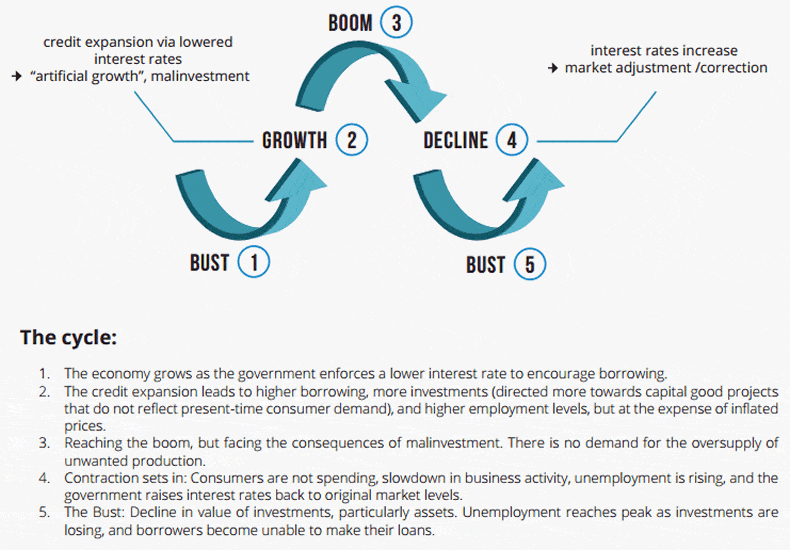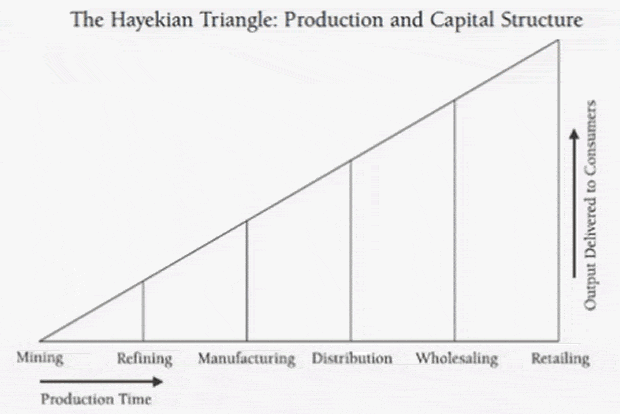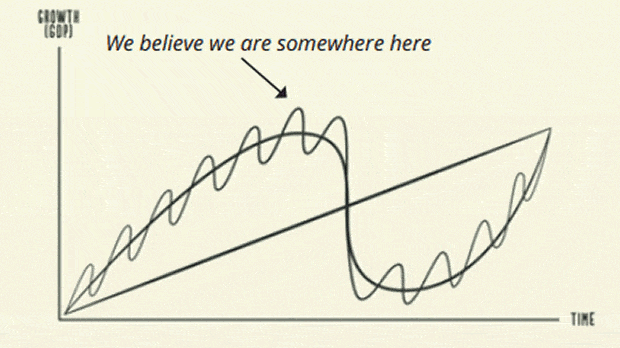Why the Economic Bust Is Inevitable According To the Austrian Business Cycle Theory
Economics / Austrian Economics Jun 06, 2014 - 01:38 AM GMTBy: GoldSilverWorlds
 The key of the ABCT is that economies operate in cycles, they go through ‘booms’ and ‘busts’, ‘expansions’ and ‘recessions.’ A ‘crisis’ should not come as a surprise. Austrian School economists argue that central banks don’t help in smoothing the amplitude of the cycles, but are actually the root cause of the business cycle. While some may view that the expansionary monetary policy can mitigate the adverse effects of a crisis, the Austrian School begs to differ.
The key of the ABCT is that economies operate in cycles, they go through ‘booms’ and ‘busts’, ‘expansions’ and ‘recessions.’ A ‘crisis’ should not come as a surprise. Austrian School economists argue that central banks don’t help in smoothing the amplitude of the cycles, but are actually the root cause of the business cycle. While some may view that the expansionary monetary policy can mitigate the adverse effects of a crisis, the Austrian School begs to differ.
The paper does an outstanding job in explaining the ABCT and applying it on the major business cycles of the modern US economy. It also answers the question whether we have seen the end of the current crisis (“bust”). Although Barack Obama believes that “we have cleared away the rubble from the financial crisis and begun to lay a new foundation for stronger, more durable economic growth”, this report will tell you otherwise.
The Austrian Business Cycle Theory
Mises and Hayek believed that business cycles are a direct cause of excessive credit flow into the market, which is facilitated by an intentionally low interest rate set by the government. The supply of credit gives the false impression that money originally saved for investment has increased. By doing so, banks mislead borrowers into believing that the pool of investible funds is bigger, and therefore they tend to do what entrepreneurs do: invest in larger production facilities or projects they originally could not afford to finance. These investments bear what economists describe as a “longer process of production”, or capital good industries that stimulate a shift of investment away from consumer goods. This shift is unsustainable, and eventually a correction ensues. The reason is that you have a market that is out of balance and falsely directed to a level of investments that is far from reality. In other words, the state has instigated unsustainable growth.

What happens when the central bank comes in and artificially lowers the interest rate? To explain we take a look at the chart below prepared by Roger Garrison. In this chart, which relies on the Hayekian triangle depicting the different stages of production, Garrison illustrates how a change in the economy’s money supply affects its structure of production. The curve of the Production Possibility Frontier (PPF) shows different combinations of consumption and investment for any given economy (chart on the top right). Any point on the PPF curve is a sustainable mix between consumption and investment (savings).
There are three main scenarios:
- In a pro-savings economy: Investments go up, encouraged by a drop in interest rates. This point on the PPF corresponding to this lower interest rate shows that the economy directs its investments to earlier stages of production. As a result, the triangle expands horizontally.
- In a pro-consumption economy: Savings and investments (discouraged by the rise in interest rates) decrease. As a result, the triangle becomes shorter from the horizontal axis as investments go to lower order consumer goods.
- In the case of a policy-induced credit expansion: This scenario is depicted in the graph as Saug. Here we have two opposing factors at play as a result of the drop in interest rate. As it appears in the graph, the new interest rate encourages both an increase in investment as well as discouraging savings. The low interest rate intersects with both S (the real supply of money by savers given that low interest rate) and Saug (the supply induced by the central bank). These are basically the “mixed signals” we were talking about earlier. Both points are located on the PPF, but meet outside the curve, implying this level is neither efficient nor sustainable.

Who is behind the boom and hence responsible for the bust?
According to the ABCT and the Austrians, it all starts with the primary engineer of the cycle: the government. Any form of state intervention is an attempt to influence markets to prolong the process of needed adjustment and reallocation of resources to more productive uses. Therefore, by manipulating interest rates, governments negatively impact the economy as creators of the growth bubble– which in essence is artificial, distorted and imbalanced.
The illusion behind the boom
The illusion lies in the misallocation of investments or ‘malinvestment’, using Mises’ terminology. This mismanagement involves two concepts: “time preference” and “forced savings”. We recommend readers to go through the explanation of these concepts in the paper (embedded at the bottom). But for now, we highlight the following: It is a play on consumer behavior: Present consumption carries more value to individuals than future consumption. When interest rates are intentionally lowered, consumers are misled to thinking more money is available, and ready to be spent – when in fact their purchasing power, as per forced saving, has weakened. In this inflationary environment, everything is an illusion. Everything has become more expensive, whether wages, commodities, services, even assets and real estate.

From boom to bust
Because the thrust of ABCT is that credit inflation is a distortion and illusion of what is actually available to support current production and consumption levels – a correction is inevitable. Mises warned, however, the longer the state of malinvestment continues, the longer and more aggressive the correction becomes. This is when everything goes down; it is a reversal of the inflationary pick up during the boom. These funds that will be accumulated will then go to future investments rather than consumption and in turn will increase the supply of goods in the future available for consumption.
So, what is the way out?
According to Mises, there is no way out of this and no way to fix this except by going through the correction process, as the economy will be undoing what caused this situation altogether.
Empirical evidence and where we are in the current cycle
Critics suggest that the lack of empirical evidence reflects the lack of explanatory power of the Austrian theory. However, many believe that the ABCT best serves to illustrate the real cause behind the boom and bust cycles of the past. One of these economists was Murray Rothbard, who traced the historical evidence of the Great Depression . In addition to the Great Depression, this paper explores the recession of 1990, the dot-com bust, and the subprime mortgage crisis. Each of these examples, we find, provide interesting perspectives and underline the validity of the ABCT.
Readers are recommended to read the analysis of the aforementioned cases in the paper, which is embedded at the bottom. In this article, we pick out the current cycle.
Since the 2007/08 global financial crisis we have seen government intervention at its peak trying to save the day. The current policy is considered the largest monetary policy actions seen in world history. We cannot really pin point our position in the cycle, but as we stated earlier in this paper, if it weren’t for state intervention in 2007/08, the correction would have been hard but short. Whether with bailouts, expansionary monetary policies, stimulus programs… the names differ but they all offer the same “temporary fix”: inject more cash into the system. The Austrian School further suggests that current governments will not reverse the situation, but rather resort to further inflationary and expansionary credit policies as damage control measures. After the collapse of Lehman Brothers and other financial institutions, we were on the verge of a bust, had it not been for the stimulus packages of US and European central banks – to postpone hitting rock bottom.
To give you a rough indication where we think we are in this cycle we would like to refer to the image below by Ray Dalio. Three lines are visible in this chart. The straight line indicates GDP growth over time if there where no credit induced growth. The other two lines show the business cycles (or debt cycles as Dalio calls them): one depicts short-term cycles and the other the long term trend. We believe that the recessions mentioned above all fall into the category of short-term variations (cycles).

Since 1971, when Nixon closed the Gold Window, we believe that we are in a booming phase in the long-term economic cycle. We believe we are reaching the top (boom phase) of this long-term cycle, meaning we are slowly but surely approaching a devastating bust. Pin pointing the tipping point is impossible in our view! This cycle has started over 40 years ago and can easily continue for years to come. Looking at where we stand on a short-term cycle basis, we think that we are approaching a top as well (possibly not the last one, before the devastating bust). We expect a sharp correction in the US economy and stock markets in the next 2-3 years. We consider the 1990 recession, the dot-com bubble and the financial crisis, which we discussed in this paper as busts of short-term cycles.
Concluding remarks
The ABCT teaches us that the government, or the central bank, is largely responsible for the boom-and-bust cycles we encounter on a regular basis. Contrary to the belief that the expansionary monetary policy through QE mitigates some of the adverse effects of the crisis, the ABCT says there is no way out. If you want to rectify the situation, you have to endure the correction process and allow the market to readjust itself.
Global Gold offers some preserving wealth tactics for down-to-earth investors:
Diversify your portfolio NOW
The risk of a bust that is unprecedented in both scope and scale is worth consideration. Even the ABCT says it is impossible to predict when the bust will happen. Timing is of the essence! We, therefore, believe that those unprepared will be the most affected. We find that a prudent portfolio structure and diversification is critical, along with appropriate risk mechanisms.
Beware of asset pricing distortions
There are numerous investment options to choose from, and one should take advantage of good opportunities when they arise. However, the manipulation of interest rates has led to substantial “illusions” and dangerous misallocations. Projects that would be considered unattractive at higher interest rates appear very attractive when interest rates are close to zero. When evaluating investments, we believe it is wise to always take this into consideration. In general, the lower the interest rates, the higher the asset prices!
Hold a part of your wealth in gold as your insurance – it’s essential
When the kind of “bust” described above eventually arrives, we consider gold a precious counter-balance to other asset classes. Holding a scarce asset with absolutely no counterparty risk affords investors a “hedge” against a crisis!
It is possible that our current monetary experiment, called QE, will end in a currency reform or hyperinflation instead of a bust. But even under such a scenario, gold and silver offer the protection needed. Gold, in particular, will remain the purest form of monetary insurance and the purest real asset which offers protection in a crisis scenario, but only if it is held physically, outside the banking system, in a jurisdiction which respects property rights.
The newest publication from Global Gold Switzerland “The Clean Slate” focuses on the theory and practice of economic cycles. In just 12 pages (download pdf), the “Austrian Business Cycle Theory” (ABCT) is explained in a simple and accessible way. Subscribe here to receive similar updates in the future via e-mail.
Read the full paper: download the paper (pdf format) on the Global Gold website.
Subscribe here to receive similar updates in the future via e-mail.
Source - http://goldsilverworlds.com/economy/why-bust-is-inevitable-according-austrian-business-cycle-theory/
© 2014 Copyright goldsilverworlds - All Rights Reserved Disclaimer: The above is a matter of opinion provided for general information purposes only and is not intended as investment advice. Information and analysis above are derived from sources and utilising methods believed to be reliable, but we cannot accept responsibility for any losses you may incur as a result of this analysis. Individuals should consult with their personal financial advisors.
© 2005-2022 http://www.MarketOracle.co.uk - The Market Oracle is a FREE Daily Financial Markets Analysis & Forecasting online publication.



